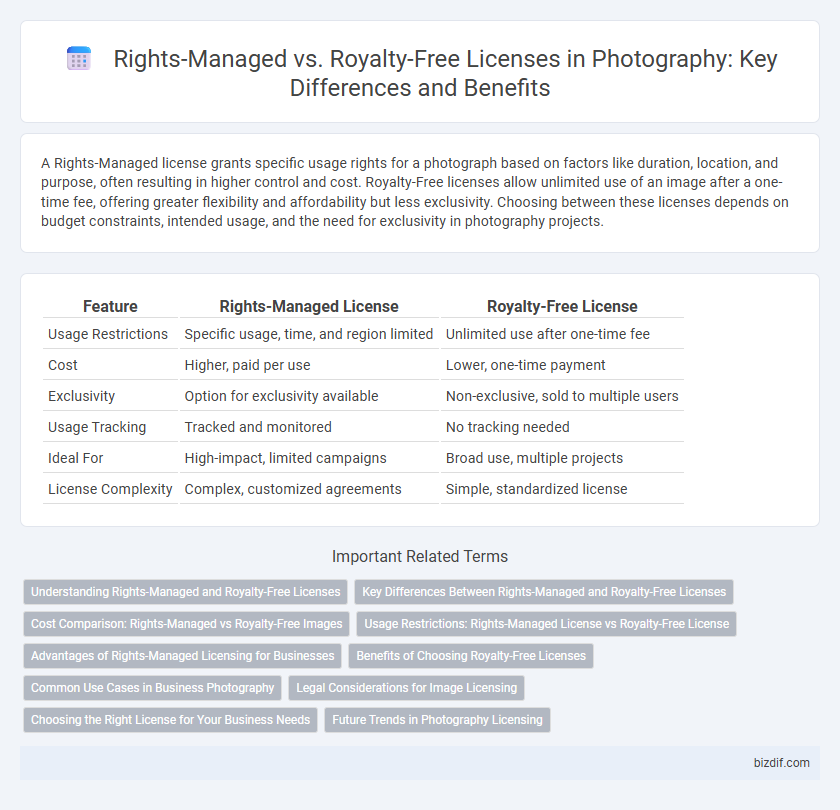A Rights-Managed license grants specific usage rights for a photograph based on factors like duration, location, and purpose, often resulting in higher control and cost. Royalty-Free licenses allow unlimited use of an image after a one-time fee, offering greater flexibility and affordability but less exclusivity. Choosing between these licenses depends on budget constraints, intended usage, and the need for exclusivity in photography projects.
Table of Comparison
| Feature | Rights-Managed License | Royalty-Free License |
|---|---|---|
| Usage Restrictions | Specific usage, time, and region limited | Unlimited use after one-time fee |
| Cost | Higher, paid per use | Lower, one-time payment |
| Exclusivity | Option for exclusivity available | Non-exclusive, sold to multiple users |
| Usage Tracking | Tracked and monitored | No tracking needed |
| Ideal For | High-impact, limited campaigns | Broad use, multiple projects |
| License Complexity | Complex, customized agreements | Simple, standardized license |
Understanding Rights-Managed and Royalty-Free Licenses
Rights-Managed licenses offer photographers controlled usage terms, including specific time frames, locations, and media, ensuring exclusive or limited use of images. Royalty-Free licenses provide buyers with broad usage rights after a one-time fee, allowing repeated use without extra charges but typically without exclusivity. Choosing between these licenses depends on balancing cost, usage flexibility, and control over image distribution in photography projects.
Key Differences Between Rights-Managed and Royalty-Free Licenses
Rights-managed licenses grant usage rights for specific, limited purposes, duration, and geographic areas, often requiring additional fees for extended use, while royalty-free licenses allow unlimited use after a one-time payment without restrictions on duration or location. Rights-managed images provide exclusivity and control, ideal for unique campaigns, whereas royalty-free images offer cost-effective flexibility suitable for multiple projects. Understanding these differences helps photographers and buyers align licensing choices with project scope and budget.
Cost Comparison: Rights-Managed vs Royalty-Free Images
Rights-managed licenses typically involve higher upfront costs and fees based on usage duration, location, and exclusivity, making them ideal for specific, limited applications with controlled distribution. Royalty-free licenses offer a one-time payment granting broad usage rights without additional fees, providing a more cost-effective solution for ongoing or varied use across multiple projects. Evaluating these options based on project budget and intended image use helps balance cost efficiency with licensing control.
Usage Restrictions: Rights-Managed License vs Royalty-Free License
Rights-managed licenses strictly control the usage parameters of a photograph, including specific duration, geographic region, and media, ensuring exclusivity and tailored rights for each use. Royalty-free licenses grant broader permissions, allowing unlimited use across multiple projects without additional fees, but typically lack exclusivity and impose fewer restrictions. Understanding these usage limitations is crucial for photographers and buyers to align licensing with project requirements and budget constraints.
Advantages of Rights-Managed Licensing for Businesses
Rights-managed licensing offers businesses exclusive usage rights, allowing precise control over where, how, and for how long the image can be used, which safeguards brand integrity and reduces misuse risks. It enables companies to negotiate tailored licensing terms that align with specific project needs and budgets, often providing a competitive advantage through unique, less widely distributed visuals. This model also facilitates effective monitoring and reporting of image usage, enhancing compliance and tracking for marketing campaigns.
Benefits of Choosing Royalty-Free Licenses
Royalty-free licenses offer photographers and buyers flexible usage rights, allowing images to be used across multiple projects without incurring additional fees, enhancing cost-efficiency. These licenses simplify licensing management by providing straightforward terms, reducing legal complexities compared to rights-managed licenses. The ability to access a broad library of images with a single purchase supports diverse creative needs while maintaining budget control for both commercial and personal projects.
Common Use Cases in Business Photography
Rights-Managed licenses offer businesses exclusive or limited-time use of specific photographs, ideal for advertising campaigns or product launches requiring controlled distribution and unique visuals. Royalty-Free licenses provide cost-effective, unlimited use of images, making them suitable for ongoing marketing materials, websites, and social media content without recurring fees. Choosing the right license depends on the business's need for exclusivity versus flexibility and budget considerations in their photography usage.
Legal Considerations for Image Licensing
Rights-managed licenses grant specific, negotiated terms for image use, ensuring control over distribution and duration but often limiting flexibility and increasing costs. Royalty-free licenses allow broader usage rights and multiple reproductions without additional fees, yet may lack exclusivity and detailed usage restrictions. Legal considerations include compliance with the license terms, understanding copyright ownership, and ensuring proper attribution to avoid infringement claims.
Choosing the Right License for Your Business Needs
Selecting the appropriate licensing model depends on your business's specific usage, budget, and exclusivity requirements. Rights-Managed licenses offer controlled, exclusive use with set terms ideal for high-profile campaigns needing strict restrictions and premium quality. Royalty-Free licenses provide flexible, multiple-use options at a lower cost, perfect for ongoing projects with broad distribution and fewer limitations.
Future Trends in Photography Licensing
Rights-Managed licenses provide exclusive usage tailored to specific clients, preserving high control and pricing flexibility, which aligns with growing demands for personalized content in commercial photography. Royalty-Free licenses continue to dominate due to their cost-effectiveness and unlimited use, supporting the rise of digital content creators and online marketing trends. Advances in blockchain for digital rights management and AI-driven licensing platforms are expected to transform future photography licensing by enhancing transparency and automation.
Rights-Managed License vs Royalty-Free License Infographic

 bizdif.com
bizdif.com